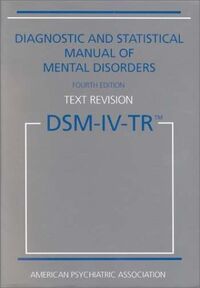
The Diagnostic and Statistical Manual published by the American Psychiatric Association
The Diagnostic and Statistical Manual of Mental Disorders, published by the American Psychiatric Association, is the handbook used most often in diagnosing mental disorders, including depression, in the United States and internationally. The International Statistical Classification of Diseases and Related Health Problems (ICD) is another alternative, commonly-used in the nursing profession.
The DSM tends to be the more specific of the two. Both assume medical concepts and terms, and state that there are categorical disorders that can be diagnosed by set lists of criteria. It is controversial and some mental health professionals and others question the utility of this classification system.
A multiaxial approach[]
The Diagnostic and Statistical Manual of Mental Disorders, presently in its fourth revised (IV-TR, 2000) edition, systemizes psychiatric diagnosis in five axes:
- Axis I: major mental disorders, developmental disorders and learning disabilities
- Axis II: underlying pervasive or personality conditions, as well as mental retardation
- Axis III: any nonpsychiatric medical condition ("somatic")
- Axis IV: social functioning and impact of symptoms
- Axis V: Global Assessment of Functioning (on a scale from 100 to 0)
Common Axis I disorders include mood disorders such as depression and bipolar disorder, anxiety disorders, ADHD, and schizophrenia. Common Axis II disorders include borderline personality disorder, schizotypal personality disorder, antisocial personality disorder, and mild mental retardation.
Major categories[]
The major categories of disorders in the DSM are as follows:
- Disorders usually first diagnosed in infancy, childhood, or adolescence - including mental retardation, learning disorders, autism, Asperger's, and attention deficit hyperactivity disorder (ADHD)
- Cognitive disorders - including delerium, dementia, Alzheimer's, and amnesia
- Substance related disorders - including addiction, withdrawal, and substance abuse
- Psychotic disorders - including schizophrenia, schizoaffective disorder, and brief psychotic disorder
- Mood disorders - including major depressive disorder, dysthymic disorder, bipolar I disorder, bipolar II disorder, and cyclothymic disorder
- Anxiety disorders - including panic disorder, agoraphobia, social phobia, other phobias, obsessive-compulsive disorder (OCD), and post-traumatic stress disorder (PTSD)
- Somatoform disorders - including hypochondraisis
- Factitious disorders
- Dissociative disorders - including dissociative amnesia and dissociative personality disorder
- Sexual and gender identity disorders
- Eating disorders - including anorexia and bulimia
- Sleep disorders - including insomnia and narcolepsy
- Other impulse control disorders
- Adjustment disorders
- Personality disorders
- Other conditions that may be a focus of clinical attention
Development[]
The DSM was initally developed to establish specific criteria for diagnosing illnesses. Prior to the DSM, diagnoses between psychiatrists was not uniform. It uses a multiaxial system in an attempt to yield a more complete picture of the patient, rather than just a simple diagnosis. The most recent version is the 'Text Revision' of the DSM-IV, also known as the DSM-IV-TR, published in 2000. The vast majority of the criteria for the diagnoses were not changed from DSM-IV. The text in between the criteria was updated. The DSM-V, is tentatively scheduled for publication in 2012, with initial planning having begun in 1999. The APA Division of Research expects to begin forming DSM development workgroups in 2007 [1].
Limitations[]
The DSM is intended for use by mental health professionals, and for use in research and administration. Appropriate use of the diagnostic criteria is said to require clinical training, and its contents "cannot simply be applied in a cookbook fashion" [2]. APA notes that diagnostic labels are primarily for use as a "convenient shorthand" among professionals for the same symptoms. Further, people sharing the same diagnosis/label may not have the same etiology (cause), or require the same treatment (the DSM contains no information on treatment or cause for this reason).
Criticism[]
The DSM is routinely attacked for being unscientific. Columbia University acknowledges the unscientific nature of the DSM in their annual report of 2001, “Problems with the current DSM-IV categorical (present vs. absent) approach to the classification of personality disorders have long been recognized by clinicians and researchers.” Among the problems, they list “arbitrary distinction between normal personality, personality traits and personality disorder” and point out the interesting fact that the most commonly diagnosed personality disorder is 301.9, Personality Disorder not Otherwise Specified.
In the United States, health insurance typically will not pay for psychological or psychiatric services unless a DSM-IV mental disease diagnosis accompanies the insurance claim. Critics claim that this may have exacerbated the ever-expanding number of disease categories. It may also cause people to be labeled with "illness" for the purpose of re-embursement. All physician services in the United States require an ICD code for health insurance payment, regardless if the patient has a definable illness or not. This is equally true of mental or physical complaints.
See also[]
External links[]
 |
This page uses content from Wikipedia. The original article was at Diagnostic and Statistical Manual of Mental Disorders. The list of authors can be seen in the page history. As with Depression Wiki, the text of Wikipedia is available under the GNU Free Documentation License. |